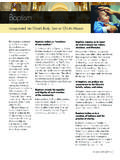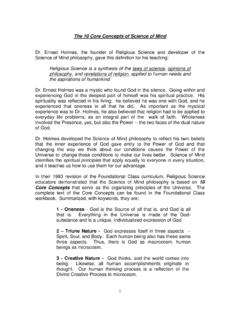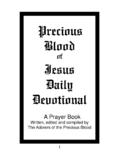Transcription of Mass and Communion Service Whats the difference
1 1 Mass and Communion Service what 's the difference ? by Thomas Richstatter, How times change! Fifty years ago, many Catholics went to Mass without receiving Communion . Today, many Catholics receive Communion without going to Mass! They receive at a Communion Service . When I was growing up, my parish had a pastor and three other priests who were full-time associate pastors. We had five Masses on Sunday and three Masses scheduled each day of the week (in addition to weddings and funerals). Today few parishes have four priests. Many only have one priest. And there are over 2,000 parishes here in the United States that currently have no priest at all.
2 In many of these parishes, on days when a priest cannot be present to celebrate the Eucharist, a Communion Service is held instead. what is a Communion Service ? I think our parish is rather typical of what parishes are doing across the country. In our parish, for example, on days when the pastor is absent, the pastoral associate, Sister Jane, leads a Communion Service . She calls the assembly together with the Sign of the Cross and a prayer. Then she (or another member of the parish) reads the Scripture passages assigned to the Mass for the day. Sister Jane then says a prayer thanking christ for the gift of the Eucharist.
3 Everyone recites the Lord s Prayer. Then Sister distributes holy Communion with hosts consecrated at a previous Mass and taken from the tabernacle. She concludes the Service with a prayer. Some parishioners call this "Sister Jane s Mass." For most I believe this is simply a humorous way of naming the Service . But for some it might indicate a misunderstanding about the essential differences between Mass and a Communion Service . Indeed, they look a lot alike; the elements of both are similar. But is a Communion Service simply "Mass without a priest"? To answer yes to this question is to miss several very important differences .
4 In this Catholic Update we will examine each of the parts of the Mass to see how a Mass is different from a Communion Service . Even if your parish does not regularly hold Communion services , this look at the structure and real meaning of the Mass will help you to participate more fully in the Eucharist. As Communion services become more frequent in parishes, there is the danger that some Catholics might not participate fully in the Eucharist because they go to Mass as if it were simply a Communion Service . These Catholics who do not completely understand the Mass go to church (and to Mass) primarily to be alone with God.
5 Greeting others, exchanging a sign of peace and other interpersonal gestures are not an integral part of the experience but rather distractions to their prayer. They receive holy Communion and treasure the moments of personal intimacy with Jesus. Communal singing at this "private" time is not to their liking. They are content with Communion services "Sister Jane s Mass." In fact "Sister Jane s Mass" in their view can be preferable to "Father s Mass" because it is shorter. what makes Mass so much different from a Communion Service ? Why is it the more ideal form of prayer?
6 To answer this question we will look at each of the parts of the Mass and compare them to the corresponding element of a Communion Service . 2 what Happens at Mass? An easy way to understand the parts of the Mass, that is, its external structure or shape, is to compare it to something with which we are all familiar, Thanksgiving dinner at Grandmother s house. what do we do when we go to Grandmother s for Thanksgiving? We 1) gather as a family, and 2) talk. We sit in the living room and tell our stories. We catch up on what has happened since the last time we were together.
7 When it s time to eat, we 3) move to the table. The turkey and all the trimmings are brought from the kitchen and 3a) are placed on the table. We 3b) say grace, and then we pass the food and we 3c) eat and drink. Refreshed by our Thanksgiving meal we 4) say our good-byes and return to our homes. The Eucharist has this same fourfold structure: 1) gathering, 2) storytelling, 3) meal sharing and 4) commissioning. Part three has three movements: 3a) the Preparation of the Gifts, 3b) the Eucharistic Prayer and 3c) the Communion Rite. We gather together When we gather for Eucharist, we do not merely come together in one place at an appointed time, like arriving at a movie theater at 7:00 because that s when the movie starts.
8 When we come together for Eucharist, we come at God s initiative. The Father calls his people together, in the Holy Spirit, to form the Body of the Son. God s call is voiced through an ordained minister who is (by his ordination) authorized by the Church to speak in the name of the Church (in persona ecclesiae). This is why the priest prays in the first person plural, , "We come to you Father, with praise and " because he is speaking for all of us. We acknowledge the prayer as our own and give our assent by our "Amen." When Catholics gather for any liturgical Service but this is especially true of the Eucharist they" express in their lives and manifest to others the mystery of christ and the real nature of the true Church" (Constitution on the Liturgy, #2).
9 Think of a jigsaw puzzle. Even disassembled, the scattered pieces in the box contain the picture. But it is only when the puzzle is assembled and the pieces fitted together that the picture becomes clear. Something similar happens at Eucharist; we are the Body of christ , but that Body only becomes visible in its fullest sense when we are called together for the liturgy. We gather as a structured community with the pastor overseeing the liturgy, just as he oversees the other dimensions of parish life. At a Communion Service , when we are called together by someone who is not authorized to speak in "the name of the Church," we gather as equals.
10 The Eucharist makes the Church become the Church in a way that a Communion Service does not. This is a very subtle difference , yet it is very important. To say that a Communion Service is simply "Mass without a priest" can overlook the essential role the assembly plays in celebrating the Eucharist. We tell our Story When a Communion Service is described as "a Mass without a priest" our attention is drawn to the fact that only the priest has the power "to speak in the name of christ " in order to consecrate the bread and wine. As wonderful as this is, priesthood involves much more than the "power to consecrate.







